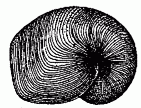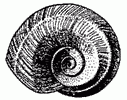



Length about 2 cm
side view (left), front view (right)
Middle Ordovician of Avalonia (England)
Length about 2 cm
side view (left), front view (right)
Late Ordovician of Armorica (Czechoslovakia)
| Bellerophontoidea | ||
| Mollusca | Bellerophontiforms |
Conchifera
└─► |
|||
None |
Mollusca |
|
Helcionelloida (paraphyletic)
├─Paragastropoda
└─┬?─Tropidodiscidae
├?─Bellerophontoidea
└─Gastropoda (crown group)
╞═Eogastropoda
└─Orthogastropoda
|
Contents
Overview |

image © xxxx Knight, et al., 1960 p.I179
The "bellerophontids" are a fairly important group of Paleozoic molluscan fossils, characterized by a distinctive planispiral, symmetrically coiled shell. As with all enigmatic extinct groups, they have a rather checkered taxonomic history. There is no doubt that they are mollusks; the question is, were they torted or not? If the former, they are gastropods, if the latter, they belong to a distinct class of early mollusks. Let us take a ride now on the see-saw world of Bellerophontology
Take a look at the following diagram. This shows the orientation of molluscan soft parts relative to the shell. Of all molluscan clades, only the gastropods undergo torsion. It seems also that torsion only happened once, it was a unique evolutionary event and responsible for much of the success gastropods have had.

(1) a rather snail-like-looking Trybliidid (remember this drawing, from Moore, et al. Invertebrate Fossils, was made before the discovery of the living Neopilina). The shell is cap-like, with a slight exogastric curve, the animal untorted. The head faces forwards, the gills (g) and anus (a) are towards the rear
(2) an untorted bellerophontid. This is basically the same bauplan as the Trybliidid, but with a fully planispirally coiled shell that curves exogastrically towards the head. The anal siphon emerges through the prominent slit in the bellerophontid shell, here pointing to the rear
(3) a torted bellerophontid. This is basically the same bauplan as a prosobranch gastropod. The mantle and shell are rotated through 180°, but thanks to the slit the anal siphon emerges to the rear of the head, thus the problem of fowling is avoided. Unlike the untorted form, the shell is now endogastrically coiled (away from the head)
(4) a pleurotomarid gastropod. This is a typical primitive gastropod. As with all gastropods, the asymmetrical (helically coiled) endogastric shell is offset slightly to one side
(5) for comparison, a nautilid cephalopod. As with most cephalopods (there were a few exceptions during the Paleozoic) the shell is exogastrically coiled, and the gills and anus are located towards the rear. Note the similarity with (2).
Now, originally bellerophontids were considered early gastropods (fig.3 in the above diagram). Without any indication of soft parts, this seems the most logical. The German palaeontologist Wenz (1940) however discovered segmented muscle scars on the Devonian bellerophont Cyrtonella mitella, in such a position as to indicate that the animal was untorted [Wagner 2001 p.1130]. He concluded that Cyrtonella, and by implication all bellerophontid were untorted, and grouped the Bellerophontacea together with the superfamily Tryblidiacea in a new subclass Amphigastropod for the untorted Gastropoda. (This was before the discovery of Neopilina and the "Monoplacophora" about 15 years later, and hence the defining of torsion as the main gastropod synapomorphy.) See figure 2 in the above diagram. Moore et al also (while not discounted alternatives) indicate that the amphigastropod interpretation is the more likely [Moore, et al. 1952, p.299-301]
J. Brookes Knight (1947), a leading specialist in Paleozoic gastropods, rejected Wenz's hypothesis by finding typically gastropod-like unsegmented columnar muscle scars on an Ordovician Sinuites and a Devonian Bellerophon, and showed that the scars are nearly identical to the retractor muscle patterns in modern archaeogastropods (now, vetigastropods). He therefore placed the bellerophontids in the "Prosobranchia" (back to fig. 3). In the Treatise volume which Knight co-authored they are considered the most primitive (or at least the first listed) of a number of "Archaeogastropod" suborders. He also considered them as ancestral to all later gastropod groups, as shown in the following diagram.

Ok, now we're all agreed, right? Wrong. Runnegar (1981) noted that although the muscle scars of some Sinuites specimens are columnar, they differed from primitive gastropod muscle scars first in being segmented, and second in having an oval, rather than a long teardrop shape. Both features are indicative of "monoplacophorans" (= tergomyans), and are also like the scars on Cyrtonella which we have seen Wenz showed to be non-torted. Therefore Runnegar (1983, 1996) concluded that Sinuites and other bellerophonts were untorted.
Also, for this and other reasons, such as the presence of a sinus in the obviously untorted Trybliidida, the association of torsion with asymmetry and of planispiral (symmetrical) coiling with the non-torted condition (e.g. shelled cephalopods), and the lack of an operculum, Salvini-Plawin 1980 pp.253-4 likewise considers bellerophontids untorted, and, in the manner of Wenz, group Bellerophontida along with the Trybliidida in a new class, Galeroconcha. The arrangement he gives, for those who are interested, is
Unfortunately, subsequent studies of several Sinuites species by Horny indicate that Sinuites specimens in fact do usually have unsegmented muscle scars, but because the scars seem to be made periodically the continuous teardrop shape representative of gastropods is not always generated and some individuals appear to have multiple individual scars. Horny therefore concluded that Sinuites was an unusual gastropod [Wagner 2001 p.1130]

Evidence of a different kind for gastropod relationships can be had in the Late Paleozoic genus Knightites (illustrated above), the shell of which is unusual in the presence of periodic pairs of "horns" or siphonal canal re-entrants in the aperture bordering the slit. Since the slit is the site for the exhalant current, the most plausible hypothesis is that the "horns" were indeed homologous to the siphonal canal of modern gastropods. So it makes no sense to reconstruct Knightites as an untorted "monoplacophoran", because that would position the inhalant currents posteriorly, which is only found in infaunal mollusks like bivalves. Knightites makes much more sense reconstructed as a torted gastropod, with the inhalant horns to the anterior where they could obtain clean oxygenated water directly in front of them. [Linsley 1978] Note that the same argument has been given to show that helcionelloids like the snorkel-baring Yochelcionellidae were endogastrically coiled. [Peel 1991]
What are we to make of all this? Some evidence indicates that Bellerophontids are gastropods, other evidence that that they are untorted. As Wagner 2001 explains:
"..workers have documented muscle scars on numerous bellerophontiform mollusks. In most cases, bellerophontiform mollusks have gastropod muscle scars. However, numerous cases exist of bellerophontiform mollusks with non-gastropod muscle scars, including some species with very similar shells to species with gastropod muscle scars."
As to how similar the shells are, take a look at the following pair, both of which are considered subgenera of the same genus by Knight, et al., 1960 p.I177.

|

|

|

|
| Sinuites bilobatus (Sowerby), a gastropod. Length about 2 cm side view (left), front view (right) Middle Ordovician of Avalonia (England) |
Sinuitopsis neglecta Cossmann, a "tergyman" Length about 2 cm side view (left), front view (right) Late Ordovician of Armorica (Czechoslovakia) |
||
Here we have Sinuites, a gastropod, and Sinuitopsis, a "monoplacophoran [Golikov and Tarobogatov 1975 p.216] drawn to the same scale. This shows how difficult, and often misleading, it is to try to identify mollusks by hard parts alone. Were it not for the muscle scar impressions both would simply be considered two closely related species of the same genus!
It is almost certain then that we are dealing with two (or perhaps more) types of bellerophonts, and that the old order or suborder is actually an artificial, polyphyletic taxon. The "bellerophontiform" shell is a type that has appeared repeatedly among early mollusks, both gastropod and non-gastropod, and "Bellerophontina" becomes something of a waste-basket taxon, not unlike the cap-like Paleozoic shells that constitute the "Monoplacophora
We would suggest therefore that the taxon "Bellerophontoidea" (and related terms, e.g. Bellerophontina) be restricted to torted bellerophontiforms, if only because the representative genus Bellerophon is of this sort. Other bellerophontiforms can be located in other gastropod or non-gastropod orders (or even classes). The Helcionellina for example that are included in Salvini-Plawin's taxonomy are actually members of a distinct paraphyletic class and grade (the Helcionelloidea). The Crytonellina can be included either under the Tergyma (another grade-assemblage) or given a class of their own, and so on. The Bellerophont see-saw is resolved by simply recognizing that bellerophontomorphs do not constitute a single monophyletic (or even paraphyletic) assemblage
page uploaded 4 March 2003
checked ATW040201
original material Creative Commons Attribution M. Alan Kazlev
all other material © original authors or sources